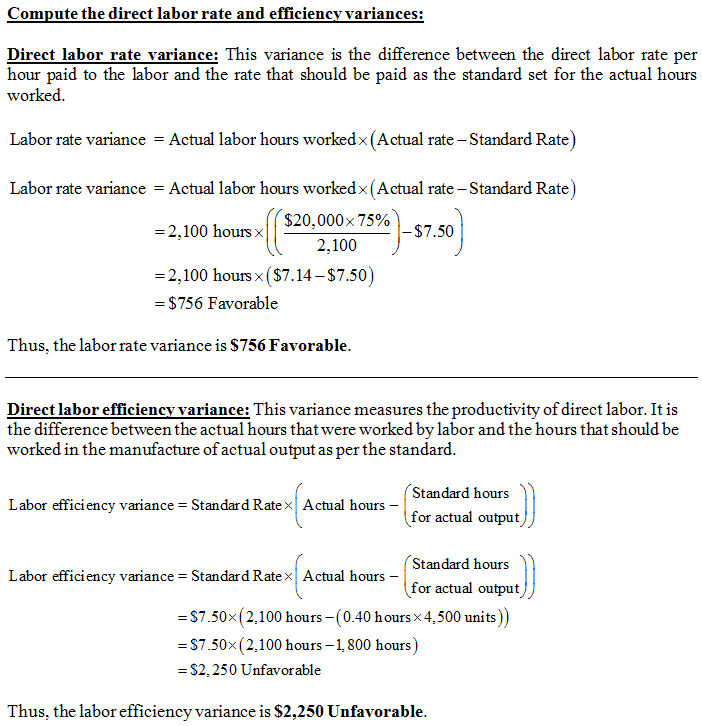Stargate Corporation has established the following standards for the costs of one unit of its product. The standard production overhead costs per unit are based on direct-labor hours. Calculation for standard per unit cost is as follows: Std Cost Std Qty Std Price/Rate Direct Material $ 14.40 6.00 kg $ 2.40 per kg Direct Labor $ 3.00 0.40 hour $ 7.50 per hour Variable Overhead $ 4.00 0.40 hour $ 10.0 per hour Fixed Overhead $ 4.80 0.40 hour $ 12.0 per hour Total $ 26.20 *based on practical capacity of 2,500 direct-labor hour per month During December 2020, Henry purchased 30,000 kg of direct material at a total cost of $75,000. The total wages for December were $20,000, 75% of which were for direct labor. Henry manufactured 4,500 units of product during December 2020, using 28,000kg of the direct material purchased in December and 2,100 direct-labor hours. Actual variable and fixed overhead cost were $23,100 and $25,000, respectively. The scheduled production for the month was 5,000 units. Required: Calculate the following variances for December 2020, indicate whether each is favorable or unfavorable, and provide brief explanation of possible reasons for the related variances: 1. The direct-labor rate variance 2. The direct-labor efficiency variance 3. The Variable Overhead spending variance
Process Costing
Process costing is a sort of operation costing which is employed to determine the value of a product at each process or stage of producing process, applicable where goods produced from a series of continuous operations or procedure.
Job Costing
Job costing is adhesive costs of each and every job involved in the production processes. It is an accounting measure. It is a method which determines the cost of specific jobs, which are performed according to the consumer’s specifications. Job costing is possible only in businesses where the production is done as per the customer’s requirement. For example, some customers order to manufacture furniture as per their needs.
ABC Costing
Cost Accounting is a form of managerial accounting that helps the company in assessing the total variable cost so as to compute the cost of production. Cost accounting is generally used by the management so as to ensure better decision-making. In comparison to financial accounting, cost accounting has to follow a set standard ad can be used flexibly by the management as per their needs. The types of Cost Accounting include – Lean Accounting, Standard Costing, Marginal Costing and Activity Based Costing.
Stargate Corporation has established the following standards for the costs of one unit of its product. The standard production
| Std Cost | Std Qty | Std Price/Rate | |
| Direct Material | $ 14.40 |
6.00 kg |
$ 2.40 per kg |
| Direct Labor | $ 3.00 |
0.40 hour |
$ 7.50 per hour |
| Variable Overhead | $ 4.00 | 0.40 hour | $ 10.0 per hour |
| Fixed Overhead | $ 4.80 | 0.40 hour | $ 12.0 per hour |
| Total | $ 26.20 |
*based on practical capacity of 2,500 direct-labor hour per month
During December 2020, Henry purchased 30,000 kg of direct material at a total cost of $75,000. The total wages for December were $20,000, 75% of which were for direct labor. Henry manufactured 4,500 units of product during December 2020, using 28,000kg of the direct material purchased in December and 2,100 direct-labor hours. Actual variable and fixed overhead cost were $23,100 and $25,000, respectively. The scheduled production for the month was 5,000 units.
Required:
Calculate the following variances for December 2020, indicate whether each is favorable or unfavorable, and provide brief explanation of possible reasons for the related variances:
1. The direct-labor rate variance
2. The direct-labor efficiency variance
3. The Variable Overhead spending variance
Standard costing: Under this costing method, the expected costs are used in the accounting records in place of actual costs and then these expected costs are compared with actual costs to analyze the variances. This costing method is useful in cost management and control.
Direct labor: It is the cost of salaries and wages incurred directly to produce a product. This cost is incurred to convert the raw materials into finished product.
Manufacturing overhead: It is the indirect cost incurred as a part of manufacturing the products. These costs are not directly related to the units manufactured. So they are allocated to the manufactured units based on estimated cost drivers.

Step by step
Solved in 3 steps with 2 images









